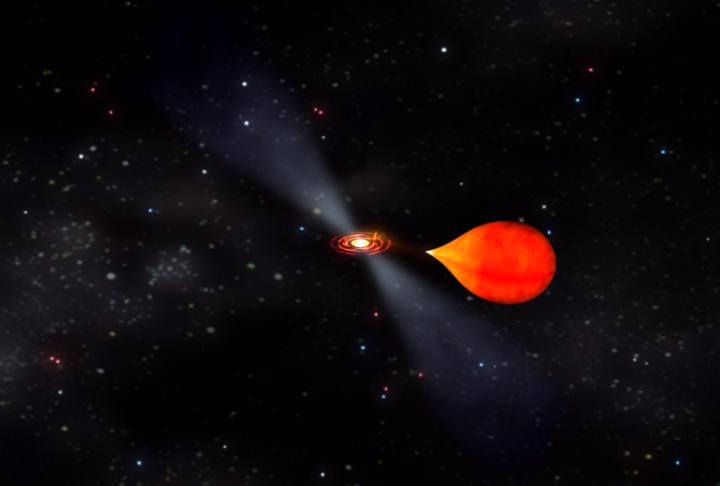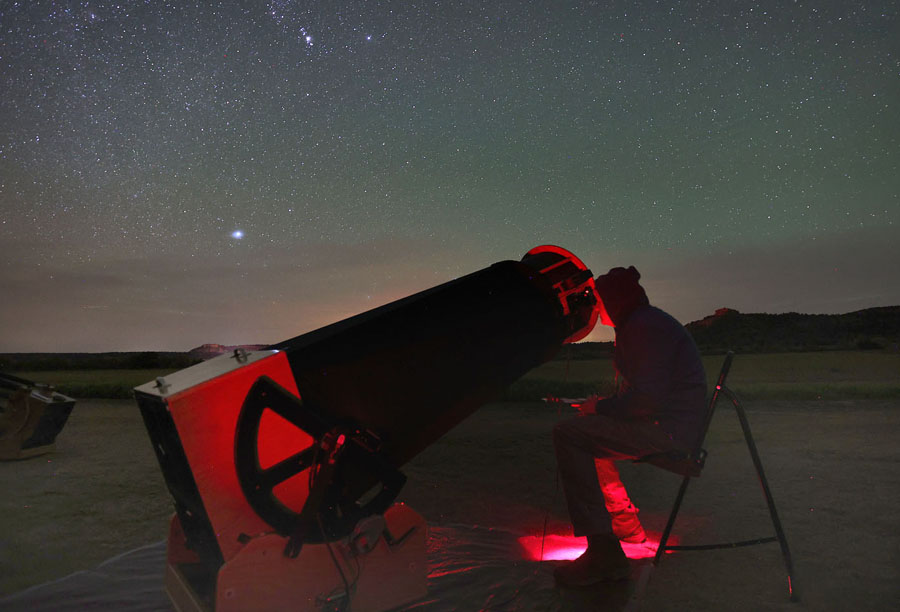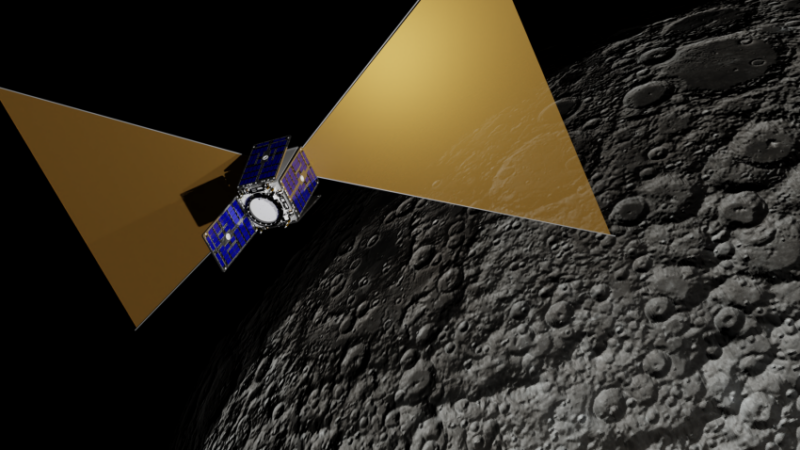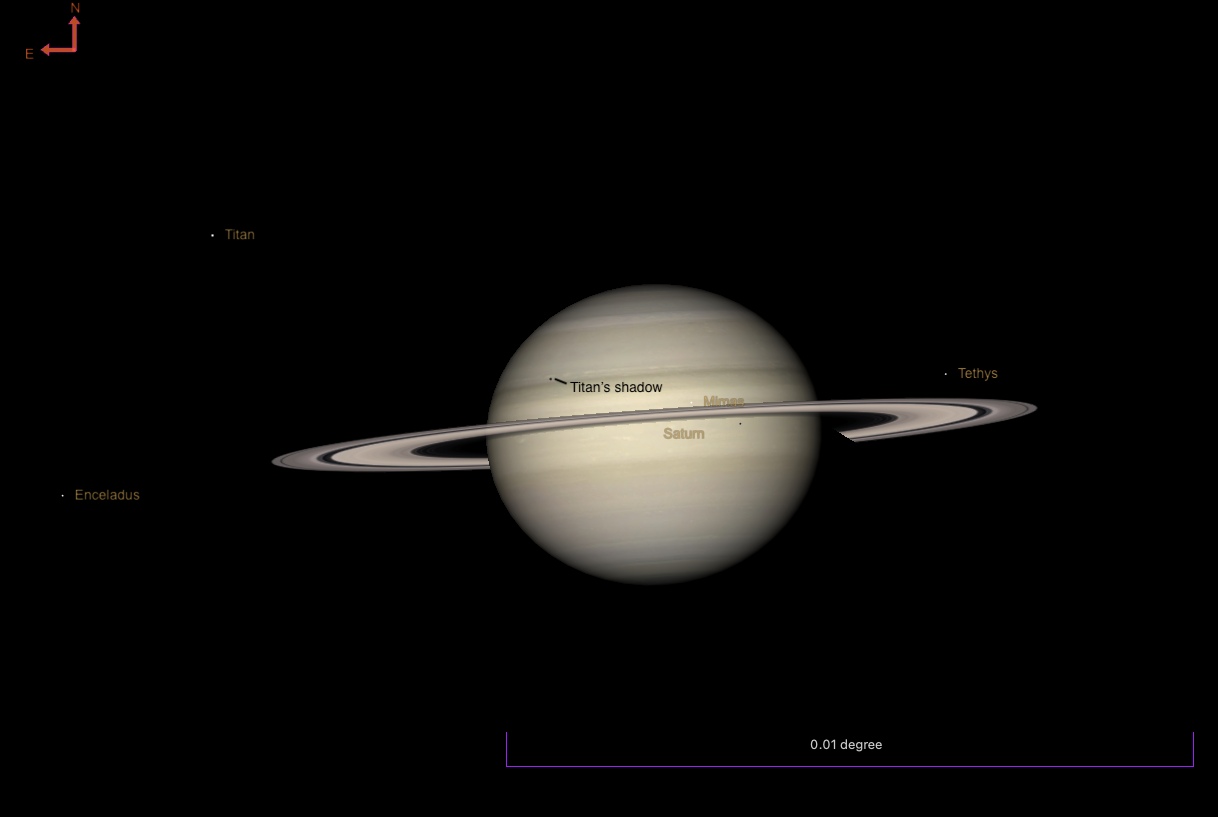*
A pulsar (left) pulls material from its companion star in this artist’s rendition. Credit: NASA
- A rapidly spinning neutron star orbits a partially destroyed star very closely.
- This is the first time such a system, predicted but never before seen, has been observed.
- The neutron star likely swallowed its companion star, then ejected its outer layers.
- “Our team has discovered nearly 770 new pulsars,” said JinLin Han.
Astronomers have spotted a rare cosmic duo: a neutron star that rotates nearly a hundred times every second locked in an ultra-tight orbit with a semi-shredded star. The scientists who found the pair say one of these stars swallowed the other whole and then spat it back out.
It’s the first discovery of a millisecond pulsar with a helium star companion – a type of system long predicted by some theories, but never observed until now. Pulsars are neutron stars that shoot beams of radiation from their poles; as they spin, these beams sweep over Earth, registering as brief blips with radio telescopes. Millisecond pulsars, specifically, are pulsars that rotate hundreds of times per second.
“You can’t get a star like the companion from normal evolution,” says JinLin Han, a professor at the Chinese Academy of Sciences, who led the study published in Science in May. “It’s a strange binary, and would have been difficult to form.”
This exotic star system was uncovered in a survey by China’s Five-hundred-meter Aperture Spherical radio Telescope (FAST), the largest single-dish radio telescope in the world. Han’s team found the pulsar, designated PSR J1928+1815, in May 2020 and observed it again later that year.
The follow-up revealed that it’s orbiting a companion very closely, separated by about the same distance as the Sun is from the outer edge of the asteroid belt. But while objects in the main belt typically take several years to lap the Sun, the newfound pulsar whirls around its companion in just 3.6 hours.
A tightening cosmic hug
Han says the binary was born as two regular stars orbiting each other – nothing unusual in our galaxy, where the majority of stars are part of a binary system. But stars evolve; as each member of a binary burns through its nuclear fuel, it undergoes changes that can affect its partner.
In this case, the heavier star in the pair used up its fuel faster and exploded in a supernova, and the leftover core was crushed to form a neutron star. Meanwhile the lighter star aged a bit more leisurely, gradually swelling up.
Since the two were close together, the neutron star began siphoning material from its companion, speeding up as more and more material fell onto it. As it lost mass, the gravity holding the companion together weakened, so it puffed up even bigger. The process altered the stars’ orbits, bringing them closer together. That only accelerated the companion star’s swelling – it got so big that its outer layers engulfed the neutron star.
“And then the trouble comes,” Han says, since such a system is unstable. The stars are destined to either merge, forming a single dense object, or blow their tops.
As the neutron star plowed through gas from its companion’s outer layers, friction slowed its orbit (though its spin was ever-increasing as it continued snatching up material). It spiraled inward, transferring energy to the surrounding gas. That, along with frictional heating – much how rubbing your hands together warms them up – helped inject enough energy to blow the companion star’s outer layers away over the course of about 1,000 years – the blink of an eye, on astronomical timescales.
The result: one very speedy spinner tightly hugging the unwrapped burning core of a star. With its outer hydrogen layers peeled away, what that remains is mainly helium the star had already fused in its center.
“Our discovery builds on the theories about the formation of compact binary pulsar systems,” says Zonglin Yang, lead author of the paper, about the findings. Scientists have theorized that such systems arise from pairings of a neutron star and a helium star. But Yang says helium stars evolve out of that stage so quickly – within about 10 million years, which is very short compared to the rest of their lives – that the odds of actually seeing one with a pulsar are extremely low.
Add to that the fact that the team estimates only a few dozen such binaries exist in our galaxy at any given time, and it’s even more exciting that they’ve identified one.
Twins or triplets?
There’s one potential problem with the discovery.
“There’s a physical law that if a binary system loses more than half its mass, the system will become unbound,” says Enrico Ramirez-Ruiz, a professor of astronomy and astrophysics at the University of California, Santa Cruz, who was not involved in the study. When the more massive star exploded and became a neutron star, Ramirez-Ruiz says that likely ejected more than half of the pair’s total mass, so the stars should have drifted apart. “How they would have stayed gravitationally bound if the companion is significantly smaller is an interesting challenge,” he says.
The supernovae blasts that create neutron stars don’t always explode evenly, which can send the neutron stars flying off in random directions. In this case, Ramirez-Ruiz suggests that kick could have happened to send the neutron star toward its companion. That could explain how the pair stayed together. “There’s also the possibility that this was originally a triple-star system,” Ramirez-Ruiz says, with the pulsar forming from two white dwarf stars that merged.
Regardless of how exactly the system formed, scientists are eager to study the “common envelope” stage (where one star swallows a neutron star) because it’s a vital part of processes like neutron star mergers that emit gravitational waves.
“The origin story of this system is very interesting, and its future is too,” Ramirez-Ruiz says.
The helium star may expand and donate even more material to the pulsar, spinning it up and emitting X-rays from the captured material. If the pulsar heats up its companion, it could dissolve it. Or the pair may come so close that they emit gravitational waves of detectable amplitudes – ripples in space-time – as they orbit each other. That kicks off a snowball effect, because emitting gravitational waves reduces the objects’ energy and angular momentum, so their orbits shrink – potentially so much that the stars will merge.
“This observation could tell us that common envelopes are common and catalysts to get two compact objects very close to each other,” Ramirez-Ruiz says.
The discovery may help us better understand how binary stars interact, share mass, and evolve into systems with fast-spinning neutron stars. Yang says the pulsar is spinning even faster than expected, raising new questions. Studying it in more detail and finding other systems like it could offer clues.
“Our team has discovered nearly 770 new pulsars,” Han says. “I wish to find even more interesting objects!” And they likely will – surveying the galaxy with unprecedented sensitivity for both regular and millisecond pulsars is sure to turn up more oddballs.





No comments! Be the first commenter?